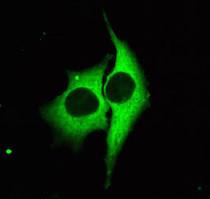
Choreographing MicroRNA and mRNA Interactions in Protein Production

Glowing cells express green fluorescent protein, which scientists used along with gene-editing techniques to uncover a new microRNA mechanism.
Credit: UT Southwestern Medical Center
MicroRNAs pair up with messenger RNAs to turn down the production of proteins. But there are far more of the messenger RNAs in the crowd, leaving scientists to ponder how the microRNAs can efficiently regulate a large excess of messenger RNA partners.
Molecular biologists at UT Southwestern Medical Center were able to uncover a new mechanism that choreographs this complex molecular dance by applying the latest in gene editing technology combined with a traditional method of making a microRNA target produce a fluorescent green protein. The successful “dance move” – called Argonaute phosphorylation – enables a microRNA to switch messenger RNA dance partners more efficiently.
“Our research addresses a fundamental question regarding how a microRNA is able to regulate a large set of target messenger RNAs, even though the microRNA is greatly outnumbered,” said Dr. Joshua Mendell, Professor of Molecular Biology and a Howard Hughes Medical Institute Investigator at UT Southwestern.
The microRNA pathway is critically important to health and disease, serving as a kind of volume control for genes, dialing down the expression of specific proteins, said Dr. Mendell, a CPRIT Scholar in Cancer Research. UTSW researchers have previously found, for example, that defects in the microRNA pathway contribute to certain childhood cancers and specific microRNAs can accelerate or inhibit cancer by regulating tumor suppressor or tumor promoting genes. MicroRNAs play important roles in many other diseases including heart disease.
CRISPR gene editing technology allowed the scientists to switch off a different gene in each cell across millions of cells. Cells became more fluorescent when genes that impacted the microRNA pathway were switched off, leading scientists to the discovery of the new phosphorylation mechanism involved in controlling microRNA-target interactions.
“This research uncovered a new and fundamental aspect of the microRNA pathway in which phosphate molecules are rapidly added and removed from key proteins in the pathway. We believe this mechanism allows microRNAs to engage target messenger RNAs, silence them, and then efficiently move on to the next target,” said first author Ryan Golden a student in the Medical Scientist Training Program at UT Southwestern and a member of the Mendell lab.
In addition to shedding new light on the microRNA pathway, researchers say the distinctive combination of techniques used to decipher the pathway should be widely applicable to other biological questions, allowing labs to quickly identify critical components of important genetic pathways.
“This study represents the first time this experimental strategy has been used to study the microRNA pathway on a genome-wide scale. It is a very powerful approach. This work lays out a methodology that could be used to study many different biomedical problems,” said Dr. Mendell, a member of the Harold C. Simmons Comprehensive Cancer Center.
###
The work, published in the journal Nature, was supported by the Howard Hughes Medical Institute and grants from Cancer Prevention and Research Institute of Texas (CPRIT), the National Institutes of Health, the Cancer Research Institute, and the Leopoldina Fellowship Program from the German National Academy of Sciences Leopoldina.
Collaborators included researchers with the Eugene McDermott Center for Human Growth and Development; Next Generation Sequencing Core; the UT Southwestern Flow Cytometry Core; the UT Southwestern Protein Chemistry Technology Core; the Quantitative Biomedical Research Center; the Harold C. Simmons Comprehensive Cancer Center; the Hamon Center for Regenerative Science and Medicine; and the Center for the Genetics of Host Defense.
Researchers were Ryan J. Golden, first author and graduate student researcher in the Medical Scientist Training Program; graduate student researchers Hema Manjunath, Andres Ramirez-Martinez, and Jiaxi Wu; postdoctoral researchers Dr. Tuo Li, Dr. Juliane Braun, and Dr. Florian Kopp; Beibei Chen, computational biologist; Dr. Xiang Chen, research specialist; Vanessa Schmid, manager of the McDermott Center Next Generation Sequencing Core; Dr. Tsung-Cheng Chang, Assistant Professor of Molecular Biology; Dr. Vincent Tagliabracci, Assistant Professor of Molecular Biology and Michael L. Rosenberg Scholar in Medical Research; Dr. Yang Xie, Associate Professor of Clinical Sciences; Dr. Zhijian Chen, Professor of Molecular Biology and the Center for the Genetics of Host Defense, Howard Hughes Medical Institute Investigator, who holds the George L. MacGregor Distinguished Chair in Biomedical Science.
About UT Southwestern Medical Center
UT Southwestern, one of the premier academic medical centers in the nation, integrates pioneering biomedical research with exceptional clinical care and education. The institution's faculty includes many distinguished members, including six who have been awarded Nobel Prizes since 1985. The faculty of almost 2,800 is responsible for groundbreaking medical advances and is committed to translating science-driven research quickly to new clinical treatments. UT Southwestern physicians provide medical care in about 80 specialties to more than 100,000 hospitalized patients and oversee approximately 2.2 million outpatient visits a year.















